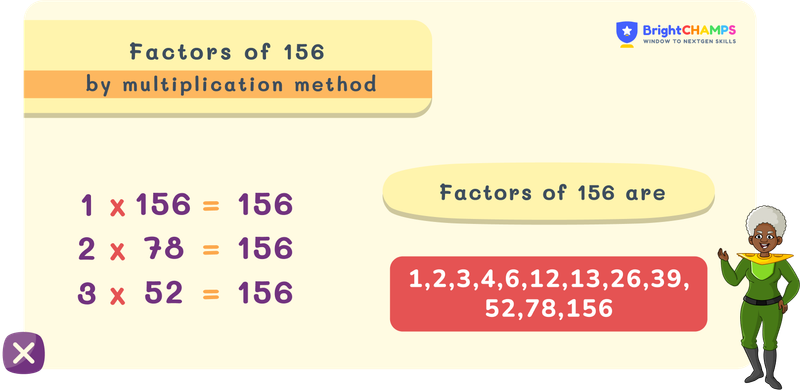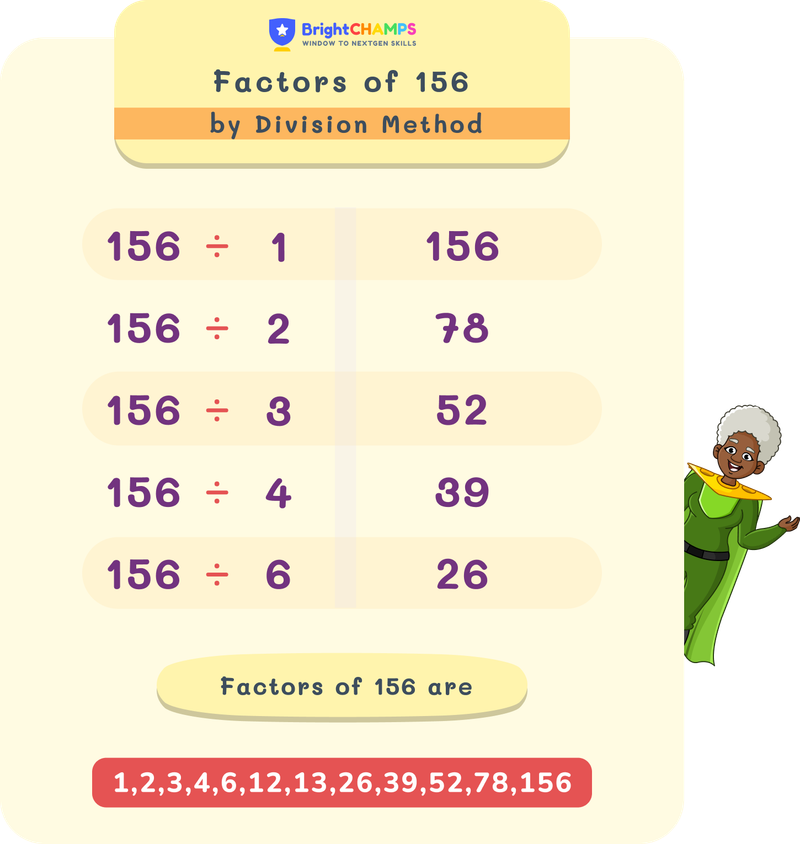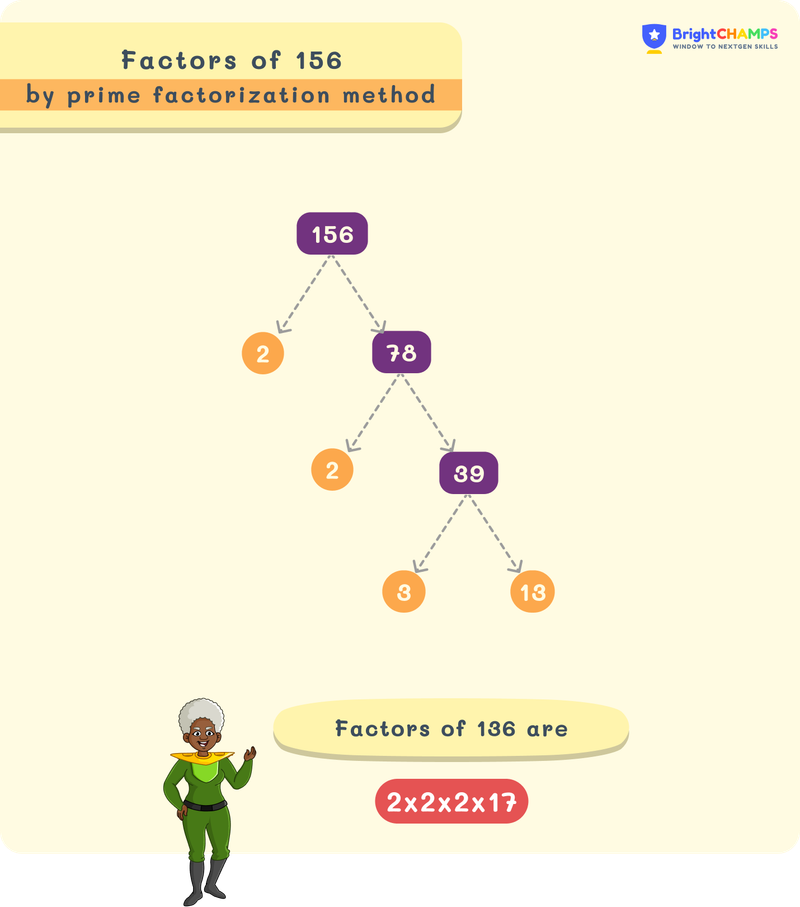
 228 Learners
228 LearnersLast updated on May 26th, 2025

Factors Of 156

In mathematics, there are lots of numbers that when divided by other numbers leave no remainder, these numbers are called factors. We use it in our vehicles mileage and money handling. Now, we’ll learn what factors are and factors of 156 let us now see.
Factors Of 156
We can tell if a number has more than 2 factors just by seeing if a number is a prime number or not. As none of the even numbers except 2 are prime numbers, we can tell that 156 has more than 2 factors. Let us find what the factors are.
Negative factors of 156: -1, -2, -3, -4, -6, -12, -13, -26, -39, -52, -78, and -156.
Prime factors of 156: The prime factors of 156 are 2, 3, and 13.
Prime factorization of 156: 2×2×3×13
The sum of factors of 156: 1+2+3+4+6+12+13+26+39+52+78+156= 392
Struggling with Math?
Get 1:1 Coaching to Boost Grades Fast !

How to find the factors of 156
Children use multiple ways to find factors of a number. Let us look at some ways we can use to find the factors of 156.
- Multiplication Method
- Division Method
- Prime Factor and Prime Factorization
Finding The Factors Of 156 Using Multiplication
In the multiplication method, we find pairs of numbers where the product will be 156. In this process, possible steps will be -
Step 1: Find all those numbers whose product will be 156.
Step 2: These numbers will be called the factors of 156.
Step 3: Students have to write these pairs of numbers for this method.
List of numbers whose product is 156
156 × 1= 156
78 × 2= 156
52×3= 156
39×4= 156
26×6= 156
13×12= 156

So the pair of numbers whose product is 156 are (1,156), (78,2), (52,3), (39,4), (26,6) and (13,12).
Finding Factors Using Division Method
For the division method, the process of division will go on until the remainder becomes zero.
Step 1: For the division method, always try the smallest number to start with. It is advisable to start dividing the number by 1, then both the number and 1 will be its factors. Example: 156÷1 = 156
Step 2: Then check with the next number to see whether the number is divided completely without any remainder. Both divisor and quotient are the factors. Example: 156÷2 = 78 and so on.

Prime Factorization And Prime Factors
Prime factorization is the process where the number will be a product of prime factors or prime numbers.
The prime factors of 156 are 2, 3, and 13. We find the prime factors of 156 by two ways.
By Prime Factorization: Here we will divide the numbers by the smallest prime number. Till we completely divide the given number. For 156, the steps are like this:
156/2= 78
78/2= 39
39/3= 13
13/13= 13
As 13 is a prime number, it is only divisible by 13. Hence, The prime factorization of the number 156 is 2×2×2×13.
Factor Tree
This is a very easy method because in many ways it’s almost the same as a prime factorization. We will break down huge numbers in this case to get what we call a factor tree.
Step 1: 156 divided by 2 gives us the answer being 78.
Step 2: 78 divided by 2 gives us 39.
Step 3: Again, we break 39 by 3, and we get 13 as our answer for 39.
Step 4: This we can’t divide further into, since 13 is a prime number.

Factor Pair
There are positive and negative factor pairs for a given number. Let us look at these factor pairs.
Positive Factor Pairs: (1,156), (78,2), (52,3), (39,4), (26,6) and (13,12).
Negative Factor Pairs: (-1,-156), (-78,-2), (-52,-3), (-39,-4), (-26,-6) and (-13,-12).

Common mistakes and how to avoid them in the factors of 156
It is very normal to make mistakes when learning to find the factors. Here are the commonly made mistakes by children. Avoid these when practising!
Level Up with a Math Certification!
2X Faster Learning (Grades 1-12)


Factors Of 156 Examples

Problem 1
A bookshelf is 156 cm long. If each shelf is 13 cm wide, how many shelves can fit?

You can fit 12 shelves, as 156÷13=12.
Explanation
To find out how many shelves fit, divide the shelf length (156 cm) by each shelf's width (13 cm).

Problem 2
If the area of a square is 156 square units, what is the length of one side?

The side length is √156= 12.49 units because the area of a square is the side length squared.
Explanation
To find the side, we take the square root of the area (√156) since area = side × side.

Problem 3
If the perimeter of a rectangle is 156 units, and its length is 52 units, what is its width?

The width is 26 units, calculated by (156−2×52)/2=26.
Explanation
Subtract twice the length (2 × 52 = 104) from the perimeter (156). Then divide by 2: (156–104) ÷ 2 = 26.

Problem 4
A group of 156 people is divided into teams of 13. How many teams are there?

There are 12 teams because 156÷13=12.
Explanation
To find the number of teams, divide the total number of people (156) by the number of people per team (13).

Problem 5
A book weighs 156 grams. If 12 books are placed together, what is their total weight?

The total weight is 1872 grams because 156×12=1872.
Explanation
Multiply the weight of one book (156 grams) by 12 to find the total weight of all 12 books.

Turn your child into a math star!
#1 Math Hack Schools Won't Teach!


FAQs For Factors Of 156
1.Is 156 a prime number?
2.Can 156 be written as a product of two factors?
3.What are the factors of 156?
4.What is the square root of 156?
5.Is 39 a factor of 156?
6.How can children in Oman use numbers in everyday life to understand Factors Of 156?
7.What are some fun ways kids in Oman can practice Factors Of 156 with numbers?
8.What role do numbers and Factors Of 156 play in helping children in Oman develop problem-solving skills?
9.How can families in Oman create number-rich environments to improve Factors Of 156 skills?
Struggling with Math?
Get 1:1 Coaching to Boost Grades Fast !

Important Glossaries for Factors of 156
- Factors: Whole numbers that can be multiplied together to yield a given number. For example, the factors of 156 include numbers like 1, 2, and 3, which divide 156 evenly without leaving a remainder.
- Prime Number: A natural number greater than 1 that has no positive divisors other than 1 and itself. Examples include 2, 3, 5, and 7.
- Remainder: The amount left over when one number is divided by another. If a number is completely divisible, the remainder is zero.
Explore More numbers
![Important Math Links Icon]() Previous to Factors Of 156
Previous to Factors Of 156
About BrightChamps in Oman


Hiralee Lalitkumar Makwana
About the Author
Hiralee Lalitkumar Makwana has almost two years of teaching experience. She is a number ninja as she loves numbers. Her interest in numbers can be seen in the way she cracks math puzzles and hidden patterns.
Fun Fact
: She loves to read number jokes and games.




